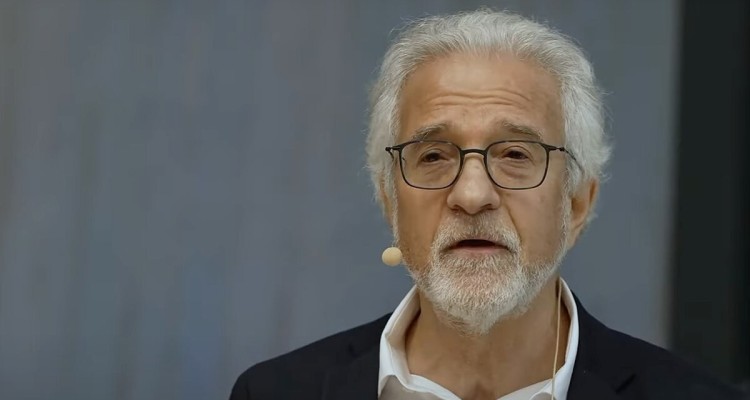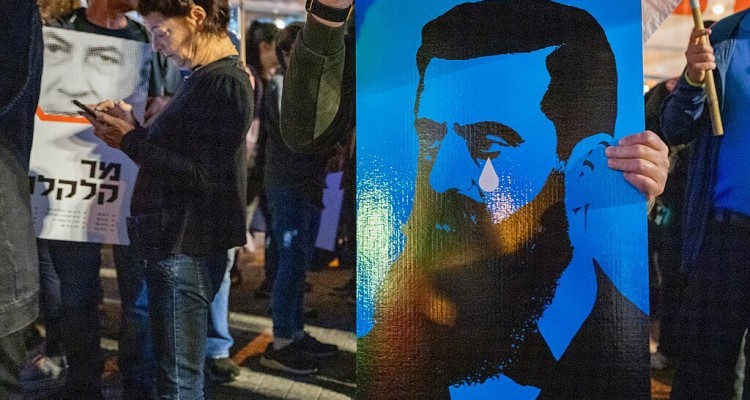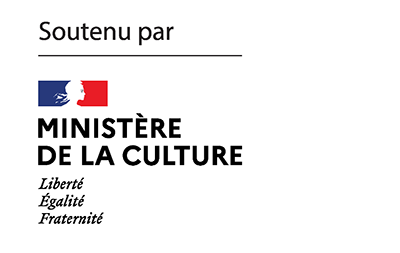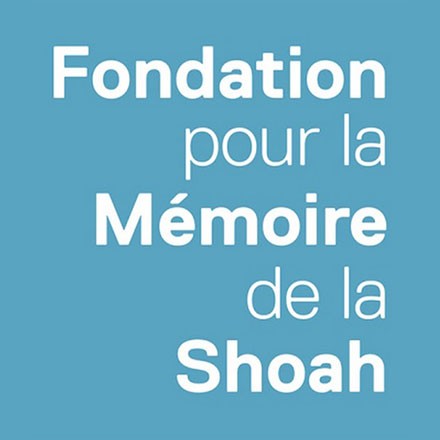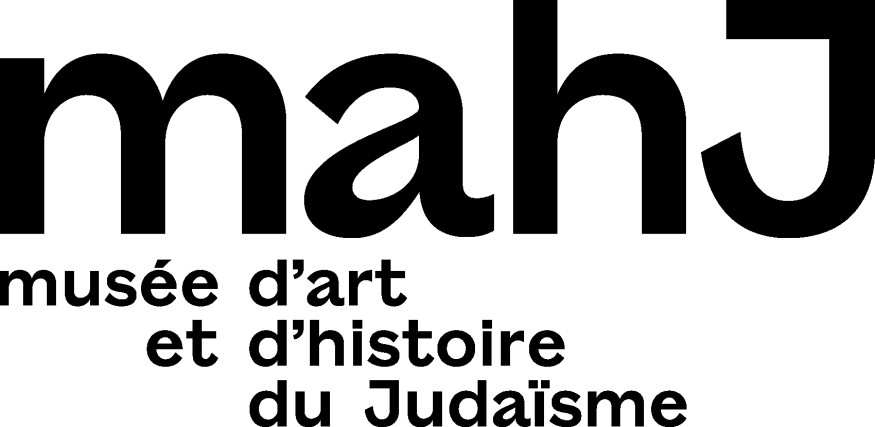Pogrom is the term by which the memory of persecution in Eastern Europe has found its way into Jewish memory. But when did it appear, and how was it used? For this text, Elena Guritanu delved into the dictionaries of the last two centuries, in order to trace the history of this term which, because it designates an undeniable horror, has itself been the object of omissions and denials.
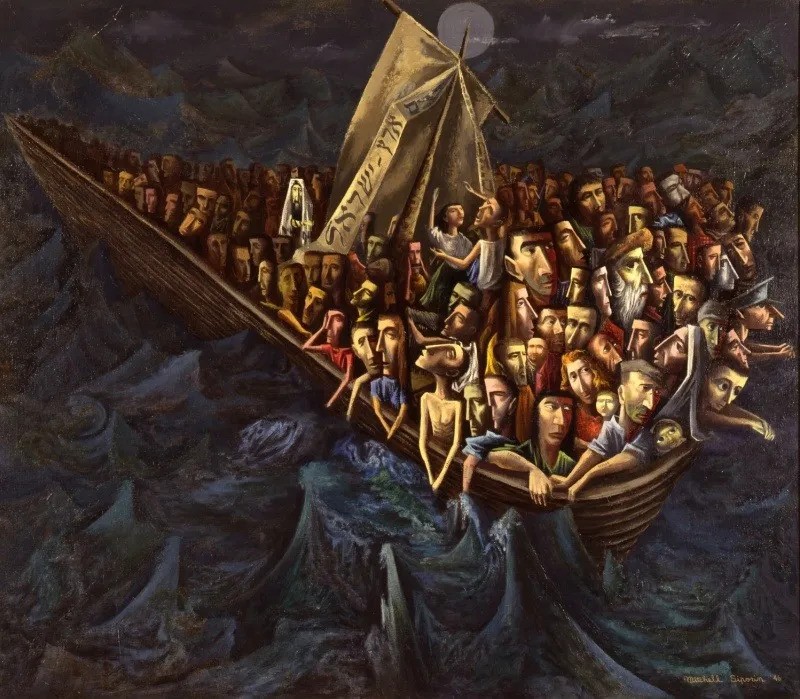
Odessa, 1821, 1859, 1871. Elisavetgrad, Kiev, Warsaw, Balta, 1881. Odessa, 1881. Kishinev, 1903. Kishinev, Jytomir, Rostov-on-Don, 1905. Białistok, 1906. Linked by the borders of the Tsarist Empire and by a Russian word for devastation. Pogrom.
First appearing in the 19th century, the word pogrom entered Russian-language dictionaries in 1897. The Brockhaus and Efron Encyclopaedic Dictionary – the Russian version of the Brockhaus Encyclopaedia, published in Germany since 1808 – was enriched with a brief article on the word pogrom – derived from the Russian verb gromit (громить – to destroy, to annihilate), whose etymological ancestor was “thunder”, grom, to which was added the perfective po. In short, the article does not include a definition, but rather a reference to the expression attack by one part of the population against another.
A pogrom is therefore not specifically “Jewish” in the first place. The massacre of Armenians in Turkey and in what is now Azerbaijan, between 1915 and 1916, was first described as a pogrom, before being redefined as genocide when the term was legally defined in 1948. In contrast, the anti-Jewish riot in Odessa in 1821 was called a pogrom a posteriori, when the word came into use in the Russian language.
The reference of “pogrom” to “attack by one part of the population against another” is not innocent, however. The locution is the almost exact title of article 269, on “Responsibility in the event of an open attack by one part of the population against another” of the Imperial Sanctions Ordinance, the equivalent of the penal code at the time. Adopted on December 9, 1891, this article of law mentions, for the first time in the history of Russian legislation, the “so-called Jewish pogroms”. It was precisely because of the number of anti-Jewish pogroms in the Russian Empire at the end of the 19th century – over 100 pogroms broke out in 1881 alone, after the assassination of Alexander II – and in order to punish the perpetrators, that this new law was enacted, punishing offenses previously punishable under Article 38, for bouïstvo, “debauchery” or “disturbance” of public order. While in practice the penalties applied were minimal or non-existent, they nonetheless conferred on the pogrom its status as a crime, and according to cold statistical reality, as an anti-Jewish crime.
The 1913 version of Pavlenkov’s Encyclopedic Dictionary[1] retains the pogrom‘s entry, but proceeds according to an opposite logic: a separate article is dedicated to anti-Jewish pogroms, whose definition mentions the notion of common pogroms (погромы общие).
The Empire’s Jewish populations, on the other hand, easily dispensed with such a distinction: Yiddish had, for decades, seized on the Russian word pogrom, without attaching any epithet to it. Just as it had done for prizyv, the call to military service, when Nicholas I made conscription of Jews compulsory at the start of his reign in 1826; for oukaze, for tchaïnik or for balalaïka, as well as for countless other Russian words that entered Jewish reality, and then into the use of the language.
The Kishinev pogrom of 1903 occupies a special place in world historiography. In the words of Steven Zipperstein, it was the Kishinev pogrom that made history tilt.
A Yiddish song, which it is impossible to date exactly, bears witness in its version about the Kishinev pogrom – to which it is dedicated and although, presumably, it predates it – to the appropriation of the word pogrom in its title:
Dos lid funem keshenever pogrom (Song about the Kishinev pogrom, דאָס ליד פֿונעם קעשענעװער פּאָגראָם)
The last day of Passover
a new razkaz[2] was given:
Let the Jews remain hidden,
they aren’t allowed in the street.
Oy, sweet God of heaven,
Look down to the earth,
See the tumult and chaos,
Are the Jews worth anything?
A house three stories high
was destroyed down to the ground.
Bedding was torn apart;
the feathers blew in the wind.
In the feathers they walked
as in winter in snow.
Women were beaten;
men torn in two.
Sweet God in heaven
Look already down to the Earth.
Have the Jews so sinned
that they are of no worth.
For there are as many versions of this song as there are “cities of slaughter”. The Kishinev massacre was one of a tragic series of Easter pogroms[3]. All they had to do was change the name of the town.
The Kishinev pogrom of 1903, however, occupies a special place in world historiography. Even today, it remains a symbol. Not because of the number of victims, 49 killed and over 500 wounded – fewer than in Odessa or Rostov-on-Don, far more deadly with their hundreds of murdered Jewish victims – but because of the repercussions it provoked, shaking the Western world with the full force of its horror. In the words of Steven Zipperstein, it was the Kishinev pogrom that made history tilt[4].
Considered a posteriori as a precursor to the Holocaust, the Kishinev pogrom became, before Buchenwald and Auschwitz, an archetype of anti-Jewish brutality. It crystallized the development of the antisemitic myth that served as the trigger for the riots: in the case of the 1903 Kishinev pogrom, the accusation of the murder of a Christian child by Jews and the Tsar’s alleged permission to “beat the Jews at Easter”. He was also the first to be photographed, and the subject of numerous international petitions and publications. We also owe him The Protocols of the Elders of Zion, the scandalous forgery that its author, Kroushevan, editor-in-chief of the antisemitic newspaper Le Bessarabe, left as a legacy to Nazism.
Pogrom (פּוֹגרוֹם) had become a common word in the Hebrew language after the series of pogroms perpetrated in the Tsarist Empire during the period following the assassination of Alexander II, between 1881 and 1884. The reality of language functions as a perfect mirror of the reality of human beings; the borrowed Russian thus entered, via Yiddish, at the same time as the barbarism it designates.
It was also Kishinev who introduced the word pogrom into the French language, as well as into many other European languages. In French, the word is first documented in 1903, in its francized form, pogrome. A late entry, however, when compared with English, which attests to the use of the word as early as 1882, in the New English Dictionary, where pogrom is defined as “riot against Jews”[5].
The Hebrew language was also a forerunner: it adopted the word pogrom (פוגרום) in the 1880s, closely following the Yiddish language in borrowing it. Brought to Palestine by Jews fleeing the pogroms of the Russian Empire, the word entered the spoken language, but remained outside the doors of Hebrew dictionaries in the making. The language in which Yossef Chaim Brenner, one of the founders of modern Hebrew, was writing as early as 1904 was certainly studded with Yiddish and Russian words, as Hebrew equivalents did not yet exist. However, the first dictionaries compiled by Eliezer Ben-Yehuda – who himself arrived in Palestine in 1881 and was determined to make Hebrew a living language long before he left Lithuania – do not include an entry for pogrom.
The Kishinev pogrom was referred to in Hebrew as Tevah (טֶבַח), “massacre”, and only recovered its Russian name long after Kishinev, when European languages adopted the word pogrom to name the slaughter that took place there.
Yet, like Yiddish, pogrom (פּוֹגרוֹם) had become a common word in the Hebrew language after the series of pogroms perpetrated in the Tsarist Empire in the period following the assassination of Alexander II, between 1881 and 1884. The reality of language functions as a perfect mirror of the reality of human beings; the borrowed Russian thus entered, via Yiddish, at the same time as the barbarism it designates.
It’s not hard to imagine that it was relegated to the spoken word in Hebrew, as were other Yiddish, Russian, Polish, Romanian or Lithuanian words, which arrived at the same time as the Jews fleeing their residential area; pogrom being too “Yiddish”, too diasporic, to formally integrate into modern Hebrew. We can also assume that Hebrew didn’t want this Russian word – a rejection as much as a hope of leaving not only the word but also Russian pogroms outside of the Eretz.
The poem “In the City of Massacre”, written in the aftermath of the Kishinev pogrom – to which Chaim Bialik was sent by the Odessa Jewish Historical Commission to gather testimonies – speaks of “massacre”, “slaughter”, “hecatomb”, “children torn apart alive” and “so many terrifying stories”, without naming the pogrom by its Russian name. The Kishinev pogrom was referred to in Hebrew as Tevah (טֶבַח), “massacre”, and only recovered its Russian name long after Kishinev, when European languages adopted the word pogrom to name the slaughter that took place there.
While contemporary Hebrew encyclopedias give a brief definition of the word pogrom without dating it, the latest editions of the New Dictionary Sapir, like Ben-Yehuda’s dictionary, still refer to the word Tevah.
The Hebrew word pogrom (פּוֹגרוֹם) thus remained associated with the Kishinev pogrom and those of the Russian Empire. It was also in reference to Kishinev that it was used after October 7, 2023, not as a signifier designating the attacks, but as a signifier of comparison. A Tevah comparable to a pogrom. Seen from Europe, and with no other word to express its horror, a pogrom.
The Russian language itself, before the Kishinev pogrom, maintains the wave of pogroms of the 1880s in a state of anomie, according to the notion Durkheim conceptualized in the 1890s. The first encyclopedic entry for the word pogrom (погром) dates, as we’ve just seen, from 1897.
Long after the Bessarabian pogroms of 1903 and 1905 and the appropriation of the word by Western languages, this “tradition” of anomie in the Russian language was perpetuated, in more or less conspicuous forms, by the Soviet and post-Soviet autocracy.
From Stalin to Gorbachev, the Russian pogrom remains a signifier without acknowledging what signified it.
Volume 24 of The Great Soviet Encyclopedia, published in 1932, includes a long article dedicated to “Jewish pogroms in Russia”, which lists over 180 Jewish victims of the pogroms that took place between 1918 and 1921, as well as over 300 children left orphaned, while glossing over those that took place under the Romanov dynasty. It also fails to mention the pogroms perpetrated by Stalin’s acolyte Boudienny’s Red Cavalry Corps in the Don region. Similarly, the article omits the “reference to the archives” that Lenin, “the most humane man” in the Soviet Union, affixed to the written request of the Jewish Section of the VKP[6] begging for an end to these crimes.
The Little Soviet Encyclopedia, published 7 years later, also includes a pogrom entry in article 354, covering anti-Jewish pogroms and Armenian-Tatar massacres in the South Caucasus. The article describes the physical violence and looting to which Jews were subjected, without ever mentioning their murder. According to this 10-volume Soviet bible, anti-Jewish “ferocious killings” took place only in Germany.
The 1940 edition of The Great Soviet Encyclopedia still contains the word pogrom. Later, the Stalinist revisionist machine made it disappear from Russian dictionaries. The 1953 and 1955 editions of the same encyclopedia thus change from pogreshnost (погрешность, “fault”) to pogrouzochnye mashiny (погрузочные машины, “utility vehicles”), regardless of the pogroms that the “Little Father of Peoples” himself supported and then initiated against the Jews of the USSR, while Soviet troops confronted the Wehrmacht[7]. Similarly, the 1968 Soviet Historical Encyclopedia omits the word pogrom, replacing its entry with pod znamenem marksizma-leninizma (под знаменем марксизма-ленинизма, “under the banner of Marxism-Leninism”), the banner under which the pages of shame were erased from Russian history.
Successive editions of the Soviet Encyclopedic Dictionary, published in the 1980s, from the early Brezhnevian era of “socialist realism” through to Gorbachev’s “perestroika”, contain around 80 thousand entries, more than double that of Pavlenkov’s 1913 Encyclopedic Dictionary, but none for pogrom. Similarly, the Great Encyclopedic Dictionary, a Russian reference dictionary published in 1998, switches from pogreshnost to pogrouzchik (погрузчик, “loader”, “carrier”) with no pogrom in between. The word does appear in the article on antisemitism, but invites the reader to look elsewhere, in Germany, for examples. So, from Stalin to Gorbachev, the Russian pogrom remains a signifier without acknowledging what signified it.
Wherever it appears, wherever it is read or heard, pogrom carries vestiges of the Russian Empire in its semantic wake, and exudes a whiff of the 19th century.
Some contemporary Russian dictionaries – whether through inadvertent error or Soviet legacy – still omit it, such as Ozhegov’s Encyclopedic Dictionary (Толковый словарь Ожегова), which mentions the word погромщик, “pogromist”, giving it the primary meaning фашистский погромщик, “fascist pogromist”, without any entry for pogrom or evocation of anti-Jewish pogroms.
After the fall of the USSR, 15,000 original documents testifying to the destruction of the Jews in Russia were sold by the heirs of the Soviet regime, for a derisory price: the KGB archives, now state-run, had become too expensive to maintain. By a fortunate coincidence, these originals found their way into the hands of a respectable buyer – the United States Holocaust Memorial Museum, inaugurated in Washington in 1993, which is both an institute for documentation and research into the history of the Holocaust, and a memorial to the millions murdered during the Holocaust.
Western dictionaries also preserve the name pogrom in its specific sense of massacre perpetrated against Jews: “Attack accompanied by looting and murder perpetrated against a Jewish community, particularly in the Russian Empire, between 1881 and 1921”, as defined by the Larousse dictionary; and in its broader generic sense of “bloody riot directed against an ethnic or religious minority”.
Webster’s New World dictionary of the American language combines both meanings in a single encyclopedic entry: “Pogrom (russ. desolation) – an organized massacre, as of Jews in Tsarist Russia“; the specific here illustrating the generic – an organized massacre, as of Jews in Tsarist Russia.
Wherever it appears, wherever it is read or heard, pogrom carries vestiges of the Russian Empire in its semantic wake, and exudes a whiff of the 19th century. In his memoir, Jours d’affliction: The Kishinev Pogrom of 1903[8], Moisei Slutskii, contemporary and witness to the Kishinev pogroms of 1903 and 1905, hoped they would be gone forever, confined to this “past century” – the nineteenth, for Slutskii, which he evokes throughout his narrative – despite their irruption in the first decades of the new century. The director of the Jewish hospital in Kishinev had hoped that modernity would get the better of antisemitism and pogroms, just as vaccination got the better of infectious diseases.
The hopes of this Jewish doctor from Bessarabia, who died in 1934, before the massacres of Jews under Stalin, before the Second World War and the Holocaust, and before the pogrom – whose modern meaning has now been extended to include terrorism attacks – of October 7, 2023, in the land of Israel, in the 21st century, were unknowingly dashed.
Tevah, pogrom.
Odessa, 1821, 1859, 1871. Elisavetgrad, Kiev, Warsaw, Balta, 1881. Odessa, 1881. Kishinev, 1903. Kishinev, Jytomir, Rostov-on-Don, 1905. Białistok, 1906. Białistok, Kaunas, Lviv, Riga, Iaşi, 1941. Kielce, 1946. Kfar Aza, Beeri, Nir Oz, 2023.
Elena Guritanu
Notes
| 1 | Florentii Fiodorovich Pavlenkov, founder, in 1907, of the eponymous publishing house in St. Petersburg. |
| 2 | Russian word meaning “narrative”, here used by alliteration in place of oukaze. |
| 3 | There were several Easter pogroms in Russia in 1882, 1883 and 1884. Outside the Russian Empire, the Lisbon pogrom, or Easter massacre of 1506, began on Easter Sunday. |
| 4 | Steven Zipperstein, Kishinev and the Tilt of the History, Liveright Publishing Corporation, 2018. |
| 5 | The broader meaning of the word pogrom, in the sense of “riot against a community or group” appears in the 1906 New English Dictionary Supplement. |
| 6 | Jewish Section of the Communist Party of the Soviet Union, |
| 7 | 1.5 million Jews were murdered in the USSR by the Nazis, between 1941 and 1945. Stalin initially supported the drafting of a Black Book to document the massacres, but when the book revealed the participation of local populations in the pogroms, he censored its publication and became an executioner in his own right |
| 8 | Moisei Borissovich Slutskii, Days of Affliction: The Kishinev Pogrom of 1903 (В скорбные дни. Кишинёвский погром 1903 года), Kishinev, 1930, reprint Nestor Istoria, 2019. |

